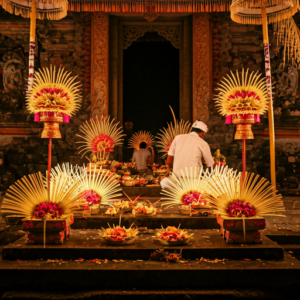What Are Hindu Offering Ceremonies?
Hindu Offering Ceremonies (Canang Sari) are a profound and deeply spiritual practice that lies at the heart of Balinese Hindu culture. These intricate and beautiful ceremonies represent more than just a religious ritual; they are a living, breathing expression of gratitude, respect, and connection to the divine. Every morning, across the island of Bali, you’ll witness local residents carefully crafting and placing these delicate offerings at various sacred and mundane spaces, creating a mesmerizing tapestry of spiritual devotion.
The term „Canang Sari“ itself carries deep meaning in Balinese culture. Canang refers to the small, square basket typically made from coconut leaf, while Sari represents the essence or soul of the offering. Hindu Offering Ceremonies are not just a simple act of placing a decorative item; they are a complex spiritual practice that connects the human world with the divine realm, maintaining a delicate balance between seen and unseen forces.
These ceremonies reflect the Balinese philosophical concept of Tri Hita Karana, which emphasizes harmony between humans, nature, and the spiritual world. Hindu Offering Ceremonies (Canang Sari) serve as a daily reminder of this interconnectedness, demonstrating how spiritual practice is seamlessly woven into everyday life.
Who Performs These Sacred Rituals?
Almost every Balinese Hindu participates in Hindu Offering Ceremonies, regardless of age or social status. From young children to elderly individuals, the practice of creating and placing Canang Sari is a communal responsibility that transcends generational boundaries. Families typically have their own unique traditions and techniques passed down through generations, making each offering a personal and familial expression of devotion.
Women often take the lead in preparing these intricate offerings. They carefully select colorful flowers, arrange them with precision, and add symbolic elements like rice, salt, and sometimes small treats. The process is meditative, requiring patience, concentration, and a deep understanding of the spiritual significance behind each component.
In Balinese society, preparing Hindu Offering Ceremonies is considered a sacred art form. Young girls learn the intricate process from their mothers and grandmothers, ensuring that this beautiful tradition continues. The skill of creating Canang Sari is not just about the final product but about understanding the spiritual intention behind each carefully placed element.
When Are These Offerings Made?
Hindu Offering Ceremonies (Canang Sari) are typically performed daily, most commonly in the early morning hours before the day’s activities begin. However, they are also made during various religious ceremonies, temple festivals, and significant life events. The timing is crucial, as each moment of the day is associated with different spiritual energies and deities.
During important Hindu ceremonies like Galungan, Kuningan, and other significant religious celebrations, the frequency and complexity of offerings increase. These periods see more elaborate and larger offerings, with entire communities coming together to create more intricate designs and more substantial spiritual tributes.
Special occasions such as birthdays, weddings, and traditional ceremonies also demand specific types of offerings. The variety and complexity of Hindu Offering Ceremonies demonstrate the rich spiritual landscape of Balinese culture, where every moment is an opportunity for spiritual connection and gratitude.
Why Are These Offerings So Important?
The significance of Hindu Offering Ceremonies goes far beyond simple religious obligation. They represent a profound spiritual philosophy that views life as a continuous cycle of giving and receiving. By creating these offerings, Balinese Hindus express gratitude to the divine, seek protection, and maintain cosmic balance.
Each element of the Canang Sari carries symbolic meaning. The colors represent different directions and divine forces: white for Shiva, red for Brahma, yellow for Vishnu, and green for more complex spiritual energies. The placement of these offerings in specific locations – temples, home compounds, street corners – is deliberate and meaningful, creating a spiritual network that connects the entire community.
These ceremonies also serve as a form of meditation and mindfulness. The act of carefully preparing and placing an offering requires complete presence and intention, helping individuals connect with their spiritual selves and the broader universe.
Where Are These Offerings Placed?
Hindu Offering Ceremonies (Canang Sari) are placed in numerous locations, each carrying its own spiritual significance. Temples are the most obvious locations, but offerings are also found in home compounds, businesses, street corners, and even on the ground of sacred spaces. This widespread practice creates a spiritual landscape that transforms the entire environment into a sacred space.
In traditional Balinese homes, offerings are typically placed at the family temple, which is usually located in the northeast corner of the compound – considered the most sacred direction. Businesses also maintain this tradition, with small offering platforms visible at the entrance, seeking divine blessing and protection.
Public spaces are equally important. You might find Canang Sari on sidewalks, near significant trees, at crossroads, and even on the steps of important buildings. These locations are believed to be inhabited by spiritual entities that require acknowledgment and respect.
How Are These Offerings Prepared?
Preparing Hindu Offering Ceremonies is an art form that requires skill, patience, and spiritual understanding. The process begins with creating the base – a small square basket woven from coconut leaves called a canang. This base is then carefully filled with symbolic elements that represent different aspects of spiritual life.
Colorful flowers are strategically placed, with each color holding specific meaning. White flowers might represent purity, red symbolizes power, yellow represents prosperity, and green signifies growth. Additional elements like rice, salt, and sometimes small crackers or sweets are added, each carrying its own spiritual significance.
The preparation is done with utmost concentration and reverence. It’s not just about creating a visually appealing object but about infusing the offering with sincere intention and spiritual energy. Women often sing soft prayers or mantras while preparing these offerings, further imbuing them with spiritual power.
Conclusion
Hindu Offering Ceremonies (Canang Sari) represent much more than a religious ritual – they are a living, breathing expression of Balinese spiritual philosophy. These daily practices maintain a delicate balance between the human and divine worlds, transforming ordinary moments into opportunities for spiritual connection and gratitude.






